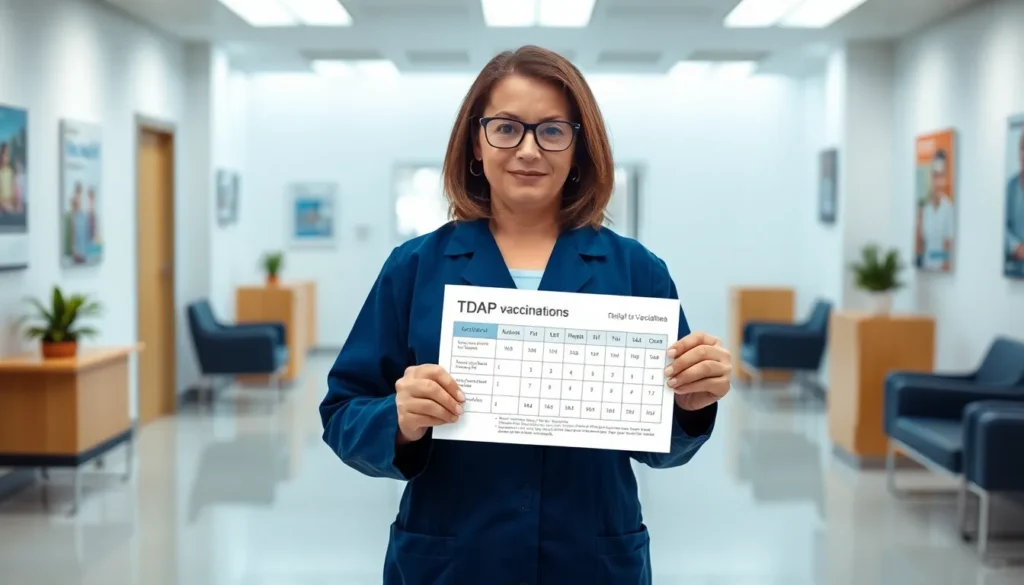Picture this: You’re at a family gathering, and your little cousin sneezes all over the potato salad. As you awkwardly try to dodge the airborne germs, a thought crosses your mind: is everyone here vaccinated? In the world of vaccinations, the Tdap, protecting against tetanus, diphtheria, and pertussis, is a superhero in disguise. It’s time to jump into why this vaccination is more crucial than a double serving of dessert at that family barbecue.
Table of Contents
ToggleOverview Of Tdap Vaccine

The Tdap vaccine is a combination shot that helps guard against three serious diseases: tetanus, diphtheria, and pertussis (also known as whooping cough). Tetanus can cause severe muscle stiffness, diphtheria can lead to breathing difficulties and heart issues, and pertussis is notorious for its uncontrollable coughing fits. This vaccine is essential for maintaining public health, especially for infants and young children.
Administered as a single shot, the Tdap vaccine is part of the routine immunization schedule, ensuring that everyone remains protected from these potentially life-threatening illnesses. The vaccine works by introducing inactivated toxins, prompting the body to develop immunity without the risk of causing the diseases themselves.
Summarizing, the Tdap vaccine is a critical component of preventive healthcare, targeting three diseases that could wreak havoc on individual health and community well-being.
The Importance Of Diphtheria, Tetanus, And Pertussis Protection
Diphtheria, tetanus, and pertussis may sound like something out of a dusty old textbook, but these diseases are far from irrelevant.
- Diphtheria: This bacterial infection can produce a thick covering in the back of the throat, leading to serious breathing difficulties. Not only does it affect individuals, but it can also risk spreading throughout communities, especially among unvaccinated populations.
- Tetanus: Often referred to as lockjaw, tetanus bacteria can enter the body through cuts or wounds. It can lead to painfully rigid muscles, even making it hard to breathe. Tetanus underscores the necessity of prompt vaccination, particularly for those often exposed to potential injuries.
- Pertussis: Known for causing severe coughing spells that can last for weeks, pertussis isn’t just a mild annoyance. It can lead to complications such as pneumonia, especially in infants. The Tdap vaccine serves as a shield against this vicious illness, highlighting its importance for community protection.
Who Should Receive The Tdap Vaccine?
The Tdap vaccine isn’t just for kids: it’s for almost everyone. The Centers for Disease Control and Prevention (CDC) recommends that:
- Adolescents: Typically, children should receive their first dose of Tdap at 11-12 years old, ensuring they’re protected during a crucial transition to high school and beyond.
- Pregnant Women: During each pregnancy, women should receive the Tdap vaccine between 27 and 36 weeks gestation to pass valuable antibodies to their infants, protecting them from pertussis in their early months.
- Adults: Anyone who hasn’t received a Tdap vaccine in the last decade should get a booster, particularly adults who expect to be in close contact with infants.
This broad recommendation ensures that the community remains shielded from outbreaks, protecting both the individual and those around them.
Tdap Vaccination Schedule
Understanding the Tdap vaccination schedule is crucial for maintaining optimal health. The vaccination usually follows this timeline:
- Children:
- First dose: Ages 11-12
- Booster: Every 10 years thereafter
- Pregnant Women:
- Recommended once per pregnancy between 27-36 weeks for the best transfer of antibodies to the baby
- Adults:
- Administered as a one-time dose if there’s been no previous vaccination in the last decade.
Following this schedule helps ensure immunity remains strong, significantly reducing the risk of contracting these diseases.
Common Side Effects And Considerations
Like all vaccines, the Tdap shot may come with a few minor side effects. Here’s what to expect:
- Local Reactions: The most common side effect is pain at the injection site, including swelling or redness.
- Systemic Reactions: Some may experience mild fever, fatigue, or headache. These symptoms typically resolve quickly, signaling that the body is building immunity.
While these side effects are generally manageable, it’s essential to monitor the vaccinated individual for more serious reactions, such as difficulty breathing or severe allergic responses. Consulting with a healthcare provider before vaccination can also address any specific concerns.
Myths And Facts About Tdap Vaccination
Uncovering the truth about the Tdap vaccine can help quell fears and misinformation. Here are a few myths debunked:
- Myth #1: Vaccines cause more harm than good.
- Fact: The benefits of Tdap vaccination far outweigh the minimal risks associated with side effects. Vaccination helps prevent severe illnesses that can lead to hospitalization or death.
- Myth #2: Only children need Tdap vaccinations.
- Fact: Adults also require boosters to maintain immunity, particularly if they come into contact with infants.
- Myth #3: Tdap vaccinations are unnecessary if I haven’t traveled.
- Fact: These diseases can spread even in non-traveling populations, emphasizing the importance of community immunity.
By dispelling these myths, individuals can make informed decisions based on facts rather than fears.




